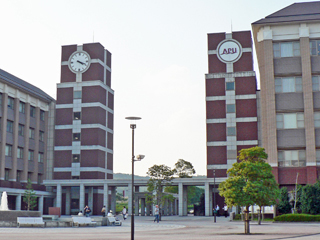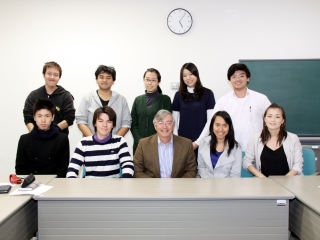An Administrators Meeting of the Tokyo Foundation’s world-scale Sylff endowment program will be held in Japan in November, to be attended by representatives of 69 universities in 44 countries. The meeting will be hosted by Ritsumeikan Asia Pacific University (APU) in Beppu, Oita. The following is a report on the internalization of Japanese universities by Professor Edgar Porter, pro-vice president for International Affairs and Faculty Development at APU.
* * *
In today’s globalized world universities must strive to be international, regardless of location and mission. To ignore this leads to irrelevance and, eventually, invisibility. Some are making excellent progress, while most struggle to find their international voice.
What does it mean to be an effective, integrated international university in today’s globalized environment? Does it mean that the university offers courses in English and strives to be a bi-lingual community? Does it mean the campus welcomes a mixture of international and domestic students on campus? Does it mean domestic students have opportunities to study abroad? Does it mean that faculty members come from different countries, offering new pedagogical approaches to the classroom? And does it mean the curriculum acknowledges international issues in all courses?
The answer lies somewhere in all of these, but if this is the extent of the commitment, then the university will fail as a true global institution. To succeed, universities must challenge the limitations of: (1) short term initiatives and (2) the traditional infrastructure and culture of university management. Universities in all countries face these tensions between the global and the local when building a dynamic international campus environment. Here Japanese institutions will be examined.
In Japan I have found an intellectual curiosity about global education, but uneven curiosity about enhancing it. The primary motivation to internationalize is the nation’s perceived need to shore up a dwindling domestic student population and workforce through expanded recruitment of international students. This national demographic crisis recently drove the Japanese government to award special status and financial incentives to 13 universities to upgrade their international education. First steps taken by these universities include recruitment of more foreign students, introduction of some English courses and hiring more teachers who can teach in English. These are good first steps, but alone they will not create dynamic global campuses. The big picture should focus on developing global citizens, both student and faculty, that will network easily throughout the world, thus enhancing Japan’s long term development from the global, rather than domestic, vantage point.
Infrastructure impediments are many. Here I will focus on faculty recruitment and authority of academic leadership. The 2009 OECD review of Japanese higher education states, “Viewed in international terms, Japanese national institutions continue to exercise less strategic initiative with respect to hiring and setting wages, reallocating resources, and exploiting investment opportunities than do comparable universities in the United States, United Kingdom, and the Netherlands.” ( OECD Reviews of Tertiary Education – Japan, 2009 ) Japanese university salary and rank are determined by age. Salaries are set across the board and are not negotiable. Merit is of little consequence. This culture of employment is far removed from that found in most places in the world that value global education, as it restricts competitive recruitment for the best and brightest faculty regardless of age.
A recent event at my university makes this point. A position was offered to a young accounting professor from the United States. The job offer was at the assistant professor level at a pre-determined salary, despite his impressive publications and teaching experiences. Upon receiving the formal contract he accepted the rank but attempted to negotiate the salary. When informed this was not negotiable, he pointed out, correctly, that his field was in high demand internationally. It did not matter, as the salary for him was the same as the salary for all teachers at that rank, regardless of subject taught. He refused the position.
Another infrastructure impediment is the traditional deference given by academic leaders to the bureaucratic managers on campus. The OECD report of 2009 argues, “Japanese universities do not yet have a pool of academic administrators with extensive management and financial experience to take on the strategic management of more autonomous and entrepreneurial university institutions.” Bureaucrats are closely tied to tradition and thus naturally resistant to dynamic change. They are also less familiar with cutting edge international education issues when compared with the academic leaders of the university. The empowerment of and dependence on the bureaucrats in universities is the reason Japan has not yet created a “pool of academic administrators” to take Japan into the future.
As an example, academic administrators at most universities have little or no control over operating and personnel budgets governing their respective offices, as this authority resides with the bureaucrats. To implement their programs and plans, academic leaders must request funding from these managers. Additionally, most have no input into the recruitment, hiring, promotion and placement of administrative staff, even those who are employed to directly support them. This tradition dates back to the creation of Japan’s imperial universities in the late nineteenth century, when staff was assigned by the government to manage the universities while professors engaged in scholarship. This system may have served the country effectively during decades of relative isolation, but continuing it today only hinders professional development and international standing of academic administrators. Many educators outside Japan question whether Japanese partners can respond quickly and compete effectively in a dynamic global environment when budgetary and staffing control resides outside the domain of the academic leadership.

Despite these problems, there are hopeful signs for Japan. Recently a few new universities have been established in Japan as “international universities.” The university where I currently work is the most ambitious. According to the Chronicle of Higher Education , Ritsumeikan Asia Pacific University (APU) “boasts something its rivals in Japan have struggled to achieve: a genuine international campus. Nearly half of its 6200 students are non-Japanese, the highest ratio of any university in the country. In addition, the institution is on the way to achieving its goal of recruiting half the faculty from abroad. Currently 44 percent of the professors and academics are from outside the island nation.” ( Chronicle of Higher Education , June 1, 2010)
In addition to these achievements, APU teaches each course in two languages, Japanese and English, with students choosing which one to use as their primary language of instruction. There are over 90 countries represented among the student population, and close to 30 among the faculty members. Official documents are printed in both Japanese and English, and faculty meetings are interpreted into both languages. The president speaks Japanese, English, and Chinese, and all vice-presidents are bilingual. Priority is given to hiring office staff with bilingual skills so student and faculty inquiries can be addressed. It is truly a multicultural, international campus, with a young but growing network of graduates scattered throughout the world.
As more experience is gained in advancing an international agenda, there are even occasional infrastructure changes. As an example, a young professor recently applied for an upgrade in rank. As she was not sure of the outcome, she also applied to another university in Japan. Both universities offered her a position, but the APU offer was lower. She asked APU to match the position of the other university. This brought on fierce debate among university executives, as the traditionalists expressed their dismay that such a tactic was used and argued that it should be rejected. It was pointed out that this was going to happen more often in the future as the university competes for the best faculty internationally. Her request was approved, showing that step by step deeper internationalization of a campus is possible.
APU, a recent recipient of a Sylff endowment administered by the Tokyo Foundation and host for the 2010 Sylff Administrators Meeting, is a progressive international university, as it either meets the standards of benchmark universities around the world, or is committed to achieving them. Yet the University faces the tension between tradition and international innovation every day. It is a slow process, but one well worth the effort. Hopefully the gains and lessons learned at APU can be helpful in guiding others to move toward incorporating greater international standards so our students can more easily contribute to a truly global environment.

